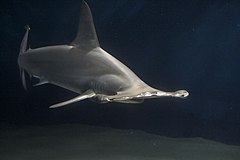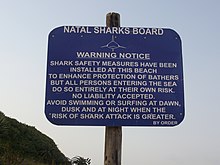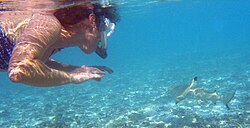From Wikipedia, the free encyclopedia
Sharks are a group of elasmobranch fish characterized by a cartilaginous skeleton, five to seven gill slits on the sides of the head, and pectoral fins that are not fused to the head. Modern sharks are classified within the clade Selachimorpha (or Selachii) and are the sister group to the rays. However, the term "shark" has also been used for extinct members of the subclass Elasmobranchii outside the Selachimorpha, such as Cladoselache and Xenacanthus, as well as other Chondrichthyes such as the holocephalid eugenedontidans. Under this broader definition, the earliest known sharks date back to more than 420 million years ago. Acanthodians are often referred to as "spiny sharks"; though they are not part of Chondrichthyes proper, they are a paraphyletic assemblage leading to cartilaginous fish as a whole.
Since then, sharks have diversified into over 500 species. They range in size from the small dwarf lanternshark (Etmopterus perryi), a deep sea species of only 17 centimetres (6.7 in) in length, to the whale shark (Rhincodon typus), the largest fish in the world, which reaches approximately 12 metres (40 ft) in length. Sharks are found in all seas and are common to depths of 2,000 metres (6,600 ft). They generally do not live in freshwater although there are a few known exceptions, such as the bull shark and the river shark, which can survive and be found in both seawater and freshwater. Sharks have a covering of dermal denticles that protects their skin from damage and parasites in addition to improving their fluid dynamics. They have numerous sets of replaceable teeth.
Well-known species such as the great white shark, tiger shark, blue shark, mako shark, thresher shark, and the hammerhead shark are apex predators—organisms at the top of their underwater food chain. Many shark populations are threatened by human activities.
Until the 16th century, sharks were known to mariners as "sea dogs". This is still evidential in several species termed "dogfish," or the porbeagle.
The etymology of the word "shark" is uncertain, the most likely etymology states that the original sense of the word was that of "predator, one who preys on others" from the Dutch schurk, meaning "villain, scoundrel" (cf. card shark, loan shark, etc.), which was later applied to the fish due to its predatory behaviour.
...
Evidence for the existence of sharks dates from the Ordovician period, 450–420 million years ago, before land vertebrates existed and before many plants had colonized the continents ]Only scales have been recovered from the first sharks and not all paleontologists agree that these are from true sharks, suspecting that these scales are actually those of thelodontagnathans. The oldest generally accepted shark scales are from about 420 million years ago, in the Silurian period.[9] The first sharks looked very different from modern sharks. The majority of modern sharks can be traced back to around 100 million years ago. Most fossils are of teeth, often in large numbers. Partial skeletons and even complete fossilized remains have been discovered. Estimates suggest that sharks grow tens of thousands of teeth over a lifetime, which explains the abundant fossils. The teeth consist of easily fossilized calcium phosphate, an apatite. When a shark dies, the decomposing skeleton breaks up, scattering the apatite prisms. Preservation requires rapid burial in bottom sediments.
...
There are more than 470 species of sharks split across thirteen orders, including four orders of sharks that have gone extinct:
...
Shark teeth are embedded in the gums rather than directly affixed to the jaw, and are constantly replaced throughout life. Multiple rows of replacement teeth grow in a groove on the inside of the jaw and steadily move forward in comparison to a conveyor belt; some sharks lose 30,000 or more teeth in their lifetime. The rate of tooth replacement varies from once every 8 to 10 days to several months. In most species, teeth are replaced one at a time as opposed to the simultaneous replacement of an entire row, which is observed in the cookiecutter shark.
Tooth shape depends on the shark's diet: those that feed on mollusks and crustaceans have dense and flattened teeth used for crushing, those that feed on fish have needle-like teeth for gripping, and those that feed on larger prey such as mammals have pointed lower teeth for gripping and triangular upper teeth with serrated edges for cutting. The teeth of plankton-feeders such as the basking shark are small and non-functional
...
Buoyancy
Unlike bony fish, sharks do not have gas-filled swim bladders for buoyancy. Instead, sharks rely on a large liver filled with oil that contains squalene, and their cartilage, which is about half the normal density of bone.[27] Their liver constitutes up to 30% of their total body mass.[31] The liver's effectiveness is limited, so sharks employ dynamic lift to maintain depth while swimming. Sand tiger sharks store air in their stomachs, using it as a form of swim bladder. Bottom-dwelling sharks, like the nurse shark, have negative buoyancy, allowing them to rest on the ocean floor.
Some sharks, if inverted or stroked on the nose, enter a natural state of tonic immobility. Researchers use this condition to handle sharks safely.[32]
Respiration
Like other fish, sharks extract oxygen from seawater as it passes over their gills. Unlike other fish, shark gill slits are not covered, but lie in a row behind the head. A modified slit called a spiracle lies just behind the eye, which assists the shark with taking in water during respiration and plays a major role in bottom–dwelling sharks. Spiracles are reduced or missing in active pelagicsharks. While the shark is moving, water passes through the mouth and over the gills in a process known as "ram ventilation". While at rest, most sharks pump water over their gills to ensure a constant supply of oxygenated water. A small number of species have lost the ability to pump water through their gills and must swim without rest. These species are obligate ram ventilators and would presumably asphyxiate if unable to move. Obligate ram ventilation is also true of some pelagic bony fish species.
The respiration and circulation process begins when deoxygenated blood travels to the shark's two-chambered heart. Here the shark pumps blood to its gills via the ventral aorta artery where it branches into afferent brachial arteries. Reoxygenation takes place in the gills and the reoxygenated blood flows into the efferent brachial arteries, which come together to form the dorsal aorta. The blood flows from the dorsal aorta throughout the body. The deoxygenated blood from the body then flows through the posterior cardinal veins and enters the posterior cardinal sinuses. From there blood enters the heart ventricle and the cycle repeats.
...
Smell
Sharks have keen olfactory senses, located in the short duct (which is not fused, unlike bony fish) between the anterior and posterior nasal openings, with some species able to detect as little as one part per million of blood in seawater.
Sharks have the ability to determine the direction of a given scent based on the timing of scent detection in each nostril. This is similar to the method mammals use to determine direction of sound.
They are more attracted to the chemicals found in the intestines of many species, and as a result often linger near or in sewage outfalls. Some species, such as nurse sharks, have external barbels that greatly increase their ability to sense prey.
...
Behavior
The classic view describes a solitary hunter, ranging the oceans in search of food. However, this applies to only a few species. Most live far more social, sedentary, benthic lives, and appear likely to have their own distinct personalities. Even solitary sharks meet for breeding or at rich hunting grounds, which may lead them to cover thousands of miles in a year. Shark migration patterns may be even more complex than in birds, with many sharks covering entire ocean basins.
Sharks can be highly social, remaining in large schools. Sometimes more than 100 scalloped hammerheads congregate around seamounts and islands, e.g., in the Gulf of California. Cross-species social hierarchies exist. For example, oceanic whitetip sharks dominate silky sharks of comparable size during feeding.
When approached too closely some sharks perform a threat display. This usually consists of exaggerated swimming movements, and can vary in intensity according to the threat level.
Speed
In general, sharks swim ("cruise") at an average speed of 8 kilometres per hour (5.0 mph), but when feeding or attacking, the average shark can reach speeds upwards of 19 kilometres per hour (12 mph). The shortfin mako shark, the fastest shark and one of the fastest fish, can burst at speeds up to 50 kilometres per hour (31 mph). The great white shark is also capable of speed bursts. These exceptions may be due to the warm-blooded, or homeothermic, nature of these sharks' physiology. Sharks can travel 70 to 80 km in a day.
Intelligence
Sharks possess brain-to-body mass ratios that are similar to mammals and birds, and have exhibited apparent curiosity and behavior resembling play in the wild.
There is evidence that juvenile lemon sharks can use observational learning in their investigation of novel objects in their environment.
Sleep
All sharks need to keep water flowing over their gills in order for them to breathe, however not all species need to be moving to do this. Those that are able to breathe while not swimming do so by using their spiracles to force water over their gills, thereby allowing them to extract oxygen from the water. It has been recorded that their eyes remain open while in this state and actively follow the movements of divers swimming around them[74] and as such they are not truly asleep.
Species that do need to swim continuously to breathe go through a process known as sleep swimming, in which the shark is essentially unconscious. It is known from experiments conducted on the spiny dogfish that its spinal cord, rather than its brain, coordinates swimming, so spiny dogfish can continue to swim while sleeping, and this also may be the case in larger shark species.
...
Range and habitat
Sharks are found in all seas. They generally do not live in fresh water, with a few exceptions such as the bull shark and the river shark which can swim both in seawater and freshwater. Sharks are common down to depths of 2,000 metres (7,000 ft), and some live even deeper, but they are almost entirely absent below 3,000 metres (10,000 ft). The deepest confirmed report of a shark is a Portuguese dogfish at 3,700 metres (12,100 ft).
Relationship with humans
Attacks
In 2006 the International Shark Attack File (ISAF) undertook an investigation into 96 alleged shark attacks, confirming 62 of them as unprovoked attacks and 16 as provoked attacks. The average number of fatalities worldwide per year between 2001 and 2006 from unprovoked shark attacks is 4.3.
Contrary to popular belief, only a few sharks are dangerous to humans. Out of more than 470 species, only four have been involved in a significant number of fatal, unprovoked attacks on humans: the great white, oceanic whitetip, tiger, and bull sharks. These sharks are large, powerful predators, and may sometimes attack and kill people. Despite being responsible for attacks on humans they have all been filmed without using a protective cage.
The perception of sharks as dangerous animals has been popularized by publicity given to a few isolated unprovoked attacks, such as the Jersey Shore shark attacks of 1916, and through popular fictional works about shark attacks, such as the Jaws film series. Jawsauthor Peter Benchley, as well as Jaws director Steven Spielberg later attempted to dispel the image of sharks as man-eating monsters.
To help avoid an unprovoked attack, humans should not wear jewelry or metal that is shiny and refrain from splashing around too much.





No comments:
Post a Comment